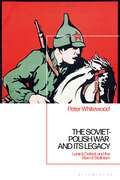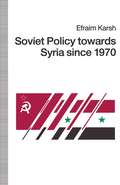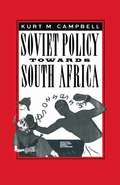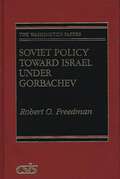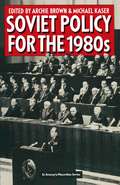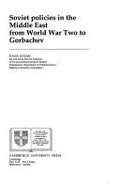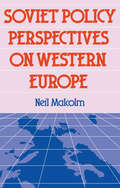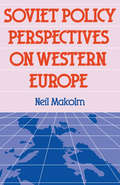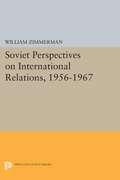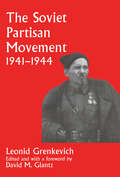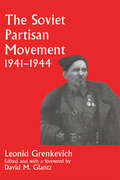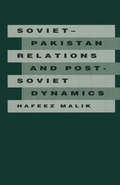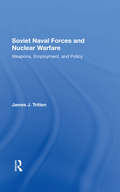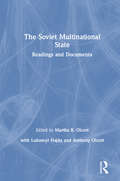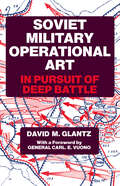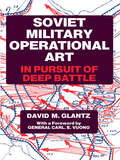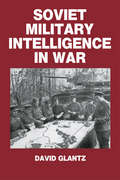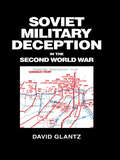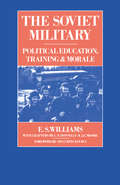- Table View
- List View
The Soviet-Polish War and its Legacy: Lenin’s Defeat and the Rise of Stalinism
by Peter WhitewoodThis detailed study traces the history of the Soviet-Polish War (1919-20), the first major international clash between the forces of communism and anti-communism, and the impact this had on Soviet Russia in the years that followed. It reflects upon how the Bolsheviks fought not only to defend the fledgling Soviet state, but also to bring the revolution to Europe. Peter Whitewood shows that while the Red Army's rapid drive to the gates of Warsaw in summer 1920 raised great hopes for world revolution, the subsequent collapse of the offensive had a more striking result. The Soviet military and political leadership drew the mistaken conclusion that they had not been defeated by the Polish Army, but by the forces of the capitalist world – Britain and France – who were perceived as having directed the war behind-the-scenes. They were taken aback by the strength of the forces of counterrevolution and convinced they had been overcome by the capitalist powers. The Soviet-Polish War and its Legacy reveals that – in the aftermath of the catastrophe at Warsaw –Lenin, Stalin and other senior Bolsheviks were convinced that another war against Poland and its capitalist backers was inevitable with this perpetual fear of war shaping the evolution of the early Soviet state. It also further encouraged the creation of a centralised and repressive one-party state and provided a powerful rationale for the breakneck industrialisation of the Soviet Union at the end of the 1920s. The Soviet leadership's central preoccupation in the 1930s was Nazi Germany; this book convincingly argues that Bolshevik perceptions of Poland and the capitalist world in the decade before were given as much significance and were ultimately crucial to the rise of Stalinism.
The Soviet-Polish War and its Legacy: Lenin’s Defeat and the Rise of Stalinism
by Peter WhitewoodThis detailed study traces the history of the Soviet-Polish War (1919-20), the first major international clash between the forces of communism and anti-communism, and the impact this had on Soviet Russia in the years that followed. It reflects upon how the Bolsheviks fought not only to defend the fledgling Soviet state, but also to bring the revolution to Europe. Peter Whitewood shows that while the Red Army's rapid drive to the gates of Warsaw in summer 1920 raised great hopes for world revolution, the subsequent collapse of the offensive had a more striking result. The Soviet military and political leadership drew the mistaken conclusion that they had not been defeated by the Polish Army, but by the forces of the capitalist world – Britain and France – who were perceived as having directed the war behind-the-scenes. They were taken aback by the strength of the forces of counterrevolution and convinced they had been overcome by the capitalist powers. The Soviet-Polish War and its Legacy reveals that – in the aftermath of the catastrophe at Warsaw –Lenin, Stalin and other senior Bolsheviks were convinced that another war against Poland and its capitalist backers was inevitable with this perpetual fear of war shaping the evolution of the early Soviet state. It also further encouraged the creation of a centralised and repressive one-party state and provided a powerful rationale for the breakneck industrialisation of the Soviet Union at the end of the 1920s. The Soviet leadership's central preoccupation in the 1930s was Nazi Germany; this book convincingly argues that Bolshevik perceptions of Poland and the capitalist world in the decade before were given as much significance and were ultimately crucial to the rise of Stalinism.
Soviet Policy towards Syria since 1970
by Efraim KarshAn examination of the nature of Soviet policy towards Syria during the last two decades, which seeks to assess Moscow's objectives and the means of achieving those objectives. The study argues that the overriding concern of Soviet policy is preservation of regional stability.
Soviet Policy Toward Israel Under Gorbachev (The Washington Papers)
by Robert Owen FreedmanMikhail Gorbachev's rise to power in 1985 signalled the beginning of significant improvements in Soviet-Israeli relations--thoroughly examined in this carefully researched volume. Based on an analysis of Soviet behavior and interviews with Israeli and Soviet Foreign Ministry officials and PLO leaders, this study describes how eased tensions between the Soviet Union and Israel have been achieved and analyzes the Soviet Union's reasons for advancing diplomatic relations with Israel.Robert Owen Freedman follows the progress of Soviet policy from the 1985 meeting between the Soviet and Israeli ambassadors to France, to the 1987 arrival of the Soviet consular delegation in Israel, which heralded rapid improvement on the diplomatic front, to the 1989 trade agreements, cultural, academic, and athletic exchanges, and the 1990 political meetings between high ranking officials. Freedman identifies three primary goals that motivated these Soviet initiatives towards Israel: a desire to improve relations with the United States; a desire to play a major role in Middle East diplomacy; and a desire for trade with Israel. Both meticulously documented and forward-looking, the conclusions reached can stimulate discussion and provide a basis for further study for members of the academic, political, and diplomatic communities.
Soviet Policies in the Middle East: From World War Two to Gorbachev (PDF)
by Galia GolanThis is a comprehensive study of Soviet policies in the Middle East. Concentrating on policy developments, Professor Golan analyses the major Soviet decisions and objectives from the end of World War II to the Gorbachev era. She pays particular attention to the wars and crises of recent years and the often problematic development of political relationships in the region. Professor Golan begins by demonstrating how, until the end of the Brezhnev period, Soviet policies towards the Middle East were principally influenced by the demands of superpower competition with the USA. This is followed by a series of broadly chronological case studies of the main Soviet alliances, such as Syria and South Yemen; and of Sadat's Egypt and Khomeni's Iran. This original and important book culminates in a study of Gorbachev's interests, initiatives, and 'new thinking' in relation to overall Soviet foreign policy objectives and the role of the Soviet Union in the region.
Soviet Pol Perspect W Europe (Chatham House Papers)
by Neil MalcolmFirst Published in 1989. Routledge is an imprint of Taylor & Francis, an informa company.
Soviet Pol Perspect W Europe
by Neil MalcolmFirst Published in 1989. Routledge is an imprint of Taylor & Francis, an informa company.
Soviet Perspectives on International Relations, 1956-1967
by William ZimmermanSerious debates and discussions on world politics in Russian journals and books have greatly increased since 1956, resulting in a steadily changing appraisal of the world political situation by the Russians. Professor Zimmerman studies that changing appraisal. He describes Soviet international relations perspectives during Khrushchev's years in power and the three years following. He uncovers the answers Soviet commentators implicitly or explicitly give to such questions as: Who, in the Soviet view, are the main actors in international politics, and what does identifying them suggest about the Soviet perspective? In the Soviet analysis, what is the global distribution of power? How do Soviet analysts characterize the capabilities, motives, and decision-making process of the United States?Contents: I. Introduction. II. The Emergence of International Relations as a Discipline. III. The Actors. IV. The Hierarchy. V. The Distribution of Power. VI. United States Foreign Policy from the Soviet Perspective. VII. The Balance of Power as System and Policy. VIII. Post-Imperialism and the Transformation of Soviet Foreign Policy.Originally published in 1969.The Princeton Legacy Library uses the latest print-on-demand technology to again make available previously out-of-print books from the distinguished backlist of Princeton University Press. These editions preserve the original texts of these important books while presenting them in durable paperback and hardcover editions. The goal of the Princeton Legacy Library is to vastly increase access to the rich scholarly heritage found in the thousands of books published by Princeton University Press since its founding in 1905.
The Soviet Partisan Movement, 1941-1944: A Critical Historiographical Analysis (Soviet (Russian) Military Experience #No. 4)
by Leonid D. GrenkevichPartisans and terrorists have dominated military history during the second half of the 20th century. Leonid Grenkevich offers an account of the shadowy partisan struggle that accompanied the Soviet Union's Great Patriotic War (1941-1945).
The Soviet Partisan Movement, 1941-1944: A Critical Historiographical Analysis (Soviet (Russian) Military Experience)
by Leonid D. GrenkevichPartisans and terrorists have dominated military history during the second half of the 20th century. Leonid Grenkevich offers an account of the shadowy partisan struggle that accompanied the Soviet Union's Great Patriotic War (1941-1945).
Soviet-Pakistan Relations and Post-Soviet Dynamics, 1947–92
by Hafeez MalikThis book deserves to be read carefully by scholars and laymen of foreign policy dealing with the former Soviet Union, Russia and South Asia, and particularly by the political leaders of India and Pakistan. The book is a multi-dimensional analysis of (a) Soviet-American rivalry; (b) Soviet determination to expand in the direction of South Asia and the Gulf; (c) the regional dynamics of the Middle East most especially Iran, Afghanistan and China, the major power in Asia.
Soviet Naval Forces And Nuclear Warfare: Weapons, Employment, And Policy
by James J TrittenBased on formal content analysis of the writings of Admiral Sergei G. Gorshkov and past Soviet ministers of defense and heads of the Politburo, James J. Tritten interprets what the Soviets say they will do in the event of nuclear war. He then constructs a hardware and exercise analysis of the strategic employment of the Soviet Navy in a nuclear war, offering three possible cases–the a bolt from the blue, with existing forces on patrol; full mobilization; and a plausible case of partial mobilization. In addition, Dr. Tritten examines, from a Soviet perspective, concepts of deterrence, the strategic goals and missions of the fleet, nuclear targeting policy, the Sea Lines of Communication (SLOC) disruption mission, and the potential for tactical nuclear warfare limited to the sea. The author concludes by assessing the implications of Soviet politico-military planning for Western defense strategy and arms control.
Soviet Naval Forces And Nuclear Warfare: Weapons, Employment, And Policy
by James J TrittenBased on formal content analysis of the writings of Admiral Sergei G. Gorshkov and past Soviet ministers of defense and heads of the Politburo, James J. Tritten interprets what the Soviets say they will do in the event of nuclear war. He then constructs a hardware and exercise analysis of the strategic employment of the Soviet Navy in a nuclear war, offering three possible cases–the a bolt from the blue, with existing forces on patrol; full mobilization; and a plausible case of partial mobilization. In addition, Dr. Tritten examines, from a Soviet perspective, concepts of deterrence, the strategic goals and missions of the fleet, nuclear targeting policy, the Sea Lines of Communication (SLOC) disruption mission, and the potential for tactical nuclear warfare limited to the sea. The author concludes by assessing the implications of Soviet politico-military planning for Western defense strategy and arms control.
The Soviet Multinational State
by Martha Brill Olcott Lubomyr Hajda Anthony OlcottThe Soviet Union is a multinational state, with about half of the country's population being ethnically Russian. The advent of glasnost, and moves toward democratization and decentralization has unleashed the expression of national sentiments and interests in the USSR. This collection of Soviet materials surveys the many ramifications of the "nationality question" in the USSR in the 1980s. The topics covered include ideology, state organization, party recruitment, inter-republican economic relations, demographic factors, education, bilingualism, cultural institutions, religious traditions, military service, and disputes over republican prerogatives (in the Baltic) and over territory (the case of Nagorno-Karabakh). Each topical section includes a detailed introduction by the editor. This anthology provides coverage of the past decade, up to and including the current unrest and the impact of the Gorbachev reforms.
The Soviet Multinational State
by Martha Brill Olcott Lubomyr Hajda Anthony OlcottThe Soviet Union is a multinational state, with about half of the country's population being ethnically Russian. The advent of glasnost, and moves toward democratization and decentralization has unleashed the expression of national sentiments and interests in the USSR. This collection of Soviet materials surveys the many ramifications of the "nationality question" in the USSR in the 1980s. The topics covered include ideology, state organization, party recruitment, inter-republican economic relations, demographic factors, education, bilingualism, cultural institutions, religious traditions, military service, and disputes over republican prerogatives (in the Baltic) and over territory (the case of Nagorno-Karabakh). Each topical section includes a detailed introduction by the editor. This anthology provides coverage of the past decade, up to and including the current unrest and the impact of the Gorbachev reforms.
Soviet Military Operational Art: In Pursuit of Deep Battle (Soviet (Russian) Military Theory and Practice)
by Colonel David GlantzDavid Glantz examines the Soviet study of war, the re-emergence of the operation level and its connection with deep battle, the evolution of the Soviet theory of operations in depth before 1941, and its refinement and application in the European theatre and the Far East between 1941 and 1945.
Soviet Military Operational Art: In Pursuit of Deep Battle (Soviet (Russian) Military Theory and Practice)
by Colonel David GlantzDavid Glantz examines the Soviet study of war, the re-emergence of the operation level and its connection with deep battle, the evolution of the Soviet theory of operations in depth before 1941, and its refinement and application in the European theatre and the Far East between 1941 and 1945.
Soviet Military Intelligence in War (Soviet (Russian) Military Theory and Practice)
by Colonel David GlantzThis text is the second of three volumes written by Colonel Glantz on the contribution of intelligence and deception operations to the Soviet victory over Nazi Germany. It examines the area where intelligence and operations overlap; the nature of co-ordination between the two; and the support provided by intelligence to operational planning and execution (or the absence of such support). This is not a study of intelligence work as such, but of how intelligence can improve the chances of success on the battlefield by facilitating the more effective and economical use of troops.
Soviet Military Intelligence in War (Soviet (Russian) Military Theory and Practice)
by Colonel David GlantzThis text is the second of three volumes written by Colonel Glantz on the contribution of intelligence and deception operations to the Soviet victory over Nazi Germany. It examines the area where intelligence and operations overlap; the nature of co-ordination between the two; and the support provided by intelligence to operational planning and execution (or the absence of such support). This is not a study of intelligence work as such, but of how intelligence can improve the chances of success on the battlefield by facilitating the more effective and economical use of troops.
Soviet Military Deception in the Second World War (Soviet (Russian) Military Theory and Practice)
by David M. GlantzPublished in 1989, Soviet Military Deception in the Second World War is a valuable contribution to the field of Military & Strategic Studies.
Soviet Military Deception in the Second World War (Soviet (Russian) Military Theory and Practice #Vol. 1)
by David M. GlantzPublished in 1989, Soviet Military Deception in the Second World War is a valuable contribution to the field of Military & Strategic Studies.
